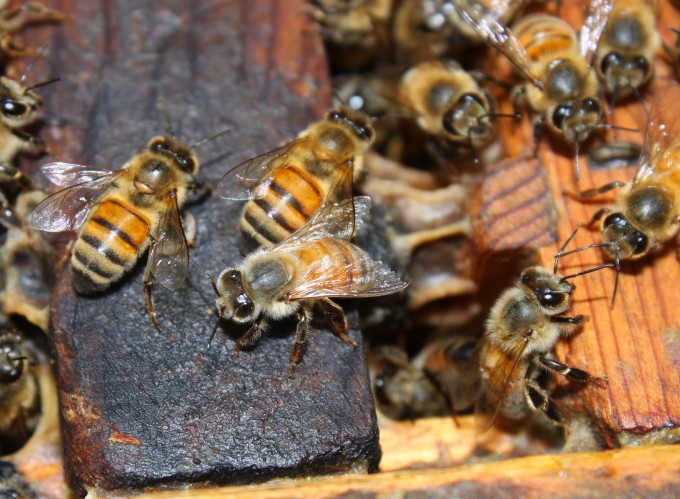Abnormal trembling of the wings and adult body; adults not able to fly; adult bees discharged from the hive crawling on the ground in front of the hive entrance and up grass or other plant stems as they unsuccessfully seek to become airborne. In cooler weather conditions infected adults may accumulate on top bars of frames in the top-most box. Sometimes, infected adults show bloated abdomens and are hairless with darker bodies.
Chronic bee paralysis virus (CBPV; sometimes a causative agent of hairless black bee syndrome) is a single-stranded RNA dicistrovirus, the largest group of honey bee-infecting pathogens. It is related to Israeli acute paralysis virus, Kashmir bee virus (KBV), and black queen cell virus. Distinction between acute bee paralysis virus (ABPV) and CBPV is not clear.
CBPV has been shown to be abundant with colony collapse disorder and weak colonies. CBPV affects adult honey bees and is easily spread to other members of a colony. Heavily infected adult bees may show abnormal trembling of the wings and body. Affected bees are thrown out of the hive where, unable to fly, they can be observed crawling on the ground and up plant stems. In some cases, crawling bees may be found in large numbers (1000+). In cooler weather, CBPV-infected bees huddle together inside the hive on the top of the cluster or on the top bars of the hive. The wings may be partially spread or dislocated.
Inbreeding may increase susceptibility to paralysis virus infection. These viruses cause individual death; if extensive, the entire colony may perish.
ABPV; KBV; hairless black bee syndrome; partially opened wing condition (K-wingK-wing:
describes adult bee wings that remain partially open rather than tightly folded on top of the abdomen, and with hind wing over front wing, resembling the letter K; caused by tracheal mite infestation. ) caused by tracheal mites.
) caused by tracheal mites.
Note: it is virtually impossible to determine if a condition is ABPV or CBPV.
McMahon DP, Wilfert L, Paxton RJ and Brown MJF. 2018. Emerging Viruses in Bees: From Molecules to Ecology. Advances in Virus Research 101: 251-291. https://www.sciencedirect.com/science/article/pii/S0065352718300113
Moore PA, Wilson ME, and Skinner JA. 2019 updated. Honey Bee Viruses, the Deadly Varroa Mite Associates. Bee Health. Accessed 2023. https://bee-health.extension.org/honey-bee-viruses-the-deadly-varroa-mite-associates/
Grozinger C, Underwood R and Lόpez-Uribe M. 2020. Viruses in Honey bees. PennState Extension. Accessed 2023. https://extension.psu.edu/viruses-in-honey-bees